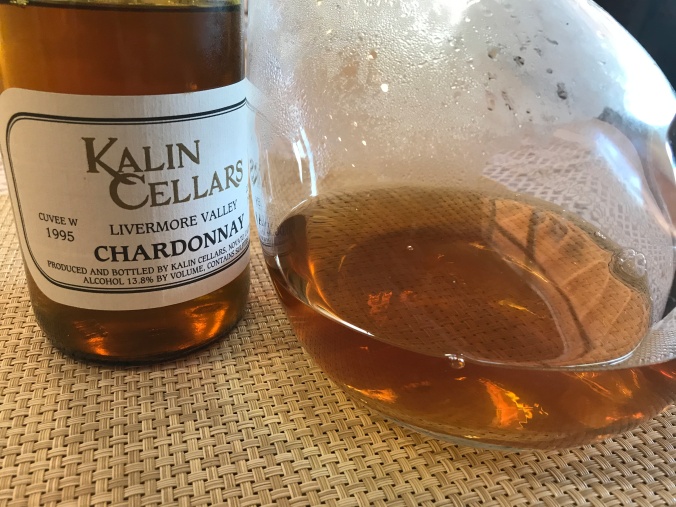I was wondering this the other day, so I googled the question and found this article. I took the following quote as a challenge:
Gregg Wilson of The Artisan Cellar in Chicago said a “nice, fat, buttery” chardonnay will “definitely become more so” as it stands.
“You’ll lose some of the acidity, naturally, if a wine is open for a while but you will gain some tertiary flavors and aromas,” he said.
Lose some acidity? How is that possible? I mean, does a glass of Coke lose anything but bubbles over two hours? And HTF does a wine gain any tertiary anything in that time? OK, sorry, putting my science hat on now. I don’t have any fat buttery chardonnays, and if I did I wouldn’t want to make them fatter and butterier, but I do have this interesting 1995 Chardonnay from Kalin Cellars (which I bought for $36 in 2016; they don’t release the wines until they think they are ready, and although the wine is aged the price isn’t).
So Amy and I sat down to a Saturday lunch of prosciutto and melon and a nice aged California Chardonnay, and conducted a breathing experiment using the usual protocol (with 2.5 hours of breathing for the decanted wine). I guessed the configuration correctly, on the usual grounds: the wine straight from the bottle had a richer aroma and, in this case, a richer more honeyed palate. This experiment also confirmed a pattern I have noticed, which is that my very first impression after three quick sniffs, without tasting, is the best guide. There was not a lot of difference between the decanter and bottle; they were both delicious. My tasting note on this wine is here.

What a lovely nut-brown honied color
What a beautiful color. Thanks for including a picture of the label – I added to the photo album on my phone where I record wines that I know are “sure things” (whether by experience or, as here, impeccable authority).
LikeLike
Aged chardonnay is a very different wine from young chardonnay. My experience of it is limited: here are two tasting notes of aged white burgundy from when we visited Sally in Paris last year.
These days white burgundy suffers from a condition called premox (premature oxidation) which makes it go brown and undrinkable after 7 years. It’s unpredictable which bottles will be attacked. Kalin Cellars seems to have avoided that problem. I won’t know how my white burgundies do for a few more years.
LikeLike